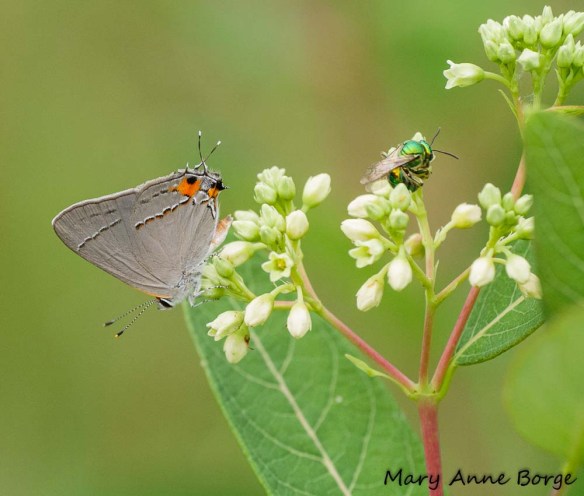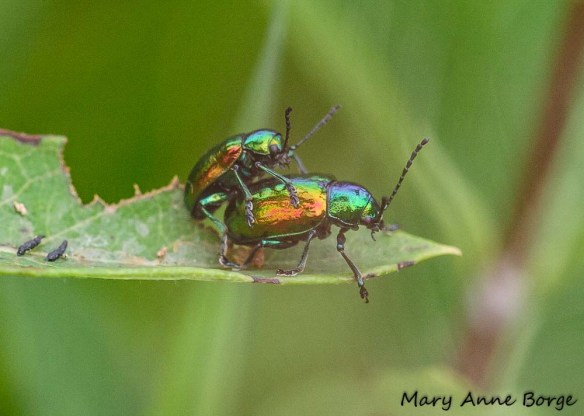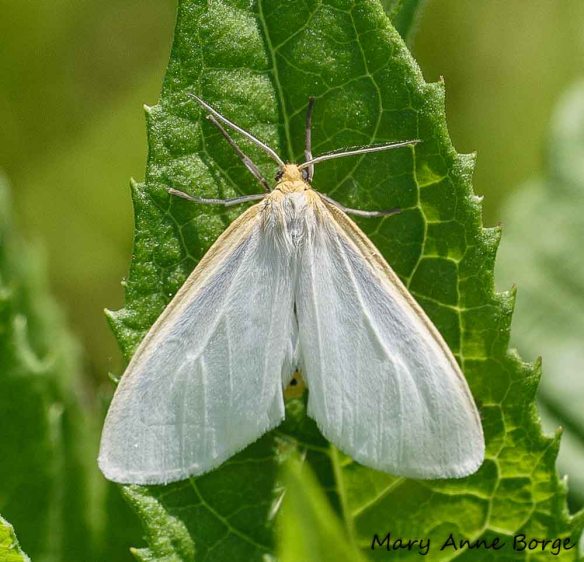A friend asked for help in identifying a plant growing on her property. She thought it was a milkweed, and she was excited at the prospect that it might attract Monarch butterflies. Milkweeds are the only food plants on which Monarch caterpillars can thrive. Monarch numbers have declined steeply in the past few years, largely due to loss of habitat and their caterpillar food plants, the milkweeds.
The plant in question turned out to be a dogbane, a species commonly called Indian Hemp (Apocynum cannabinum). There is a closely related species called Spreading Dogbane (Apocynum androsaemifolium), but Indian Hemp is the species I see most often. These two species also interbreed.
It’s easy to understand how my friend was fooled, since Indian Hemp and the other dogbane species resemble milkweeds. You might even say there is a family resemblance, since milkweeds are in the Dogbane (Apocynaceae) family. Both have simple, opposite, untoothed oval leaves with a strong midvein, and look similar at a glance.
My friend, disappointed that the plants weren’t a milkweed species, asked ‘What good is dogbane?’.
Plenty, as it turns out. It’s a great source of nectar in early summer, before many other species start blooming. The US Department of Agriculture – Natural Resources Conservation Service (USDA NRCS) ranks Indian Hemp’s value to pollinators as ‘very high’. Many bee species are frequent visitors to Indian Hemp, feeding on both nectar and pollen.
Butterflies also visit Indian Hemp for its nectar.
Many other beneficial insects can be found feeding on Indian Hemp. Adult Pennsylvania Leatherwings (Chauliognathus pensylvanicus), sometimes called Goldenrod Soldier Beetles, are known for foraging on goldenrods for pollen, but they visit a variety of other flowers, including Indian Hemp. Their larvae prey on the eggs and larvae of other insects, helping to keep those other insect populations in check.
Tachinid flies may visit Indian Hemp for nectar. These beneficial critters lay eggs on nymph or adult insects, some of which are harmful to crops or to plants in general, including stink bugs, squash bugs, and even Gypsy Moths and Japanese Beetles. Their larvae live inside these host insects, feeding on their insides. This prevents the victimized insects from reproducing, and ultimately kills them. (Science fiction writers, eat your hearts out!)
Small Milkweed Bugs (Lygaeus kalmii) are primarily seed eaters, but they have a broader palate than their name implies. The adults feed on a variety of food sources, including nectar from many flowers such as the dogbanes.
When Dogbane flowers are pollinated, they produce a pair of fruits, reflecting the structure of the flowers’ reproductive parts. Each flower has two ovaries, and each ovary produces one fruit called a follicle, a dry (not fleshy) fruit that splits open along one seam to release the many seeds inside. Small Milkweed Bug nymphs feed on dogbane seeds in addition to milkweeds, as well as the seeds of some other plants.
Dogbanes even have a beetle named after them, the Dogbane Beetle (Chrysochus auratus). This insect feeds primarily on various parts of plants in the Dogbane family throughout its life cycle. It’s appearance is often compared to that of the Japanese Beetle, but it’s much more beautiful, with distinctive iridescent red, blue-green and copper coloring.
Dogbanes are among the food plants used by the caterpillars of the Snowberry Clearwing moth,
and of the Delicate Cycnia, also called the Dogbane Tiger Moth (Cycnia tenera).
Like the milkweeds, dogbane stems contain fibers that can be used to make rope. The common name Indian Hemp is based on the fact that this species is a particularly good source for these fibers, and were used by Native Americans for this purpose.
Birds take advantage of these fibers and the fluff from dogbane seeds for nest-building, just as they do with the fibers and seed fluff from milkweeds. (See Milkweed – It’s not just for Monarchs.)
Dogbanes share some of the chemical compounds, including cardiac glycosides, that make milkweeds indigestible or toxic to many herbivores that would otherwise eat them. These chemicals are especially potent in Indian Hemp. A few sources (Natural History Museum; The Book of Swamp and Bog by John Eastman) say that Monarchs may use Spreading Dogbane as a caterpillar food plant. Since the protection offered by sequestering these chemicals in parts of their bodies is the reason Monarchs have evolved to specialize on Milkweeds, maybe they can evolve to use dogbanes, too. Have you ever seen a Monarch caterpillar on a dogbane? (I haven’t, but I’ll keep looking!)
Even without Monarchs, dogbanes are pretty productive plants!
Resources
Eastman, John. The Book of Swamp and Bog. 1995.
Eaton, Eric R.; Kauffman, Ken. Kaufman Field Guide to Insects of North America. 2007.
Elpel, Thomas J. Botany in a Day. 2006.
Evans, Arthur V. Beetles of Eastern North America. 2014.
Rhoads, Ann Fowler; Block, Timothy A. The Plants of Pennsylvania of Pennsylvania. 2007.
Pollinator-friendly Plants for the Northeastern United States (USDA NRCS)
NRCS Wildflower Plant Characteristics for Pollinator and Conservation Plantings in the Northeast
Enhancing Farm Landscapes for Native Bees and Improved Crop Pollination
Native Plants and Ecosystem Services
Tachinid flies:
Attracting Beneficial Bugs
USDA National Agroforestry Center
Beneficial Insects and Spiders in Your Maine Backyard
Small Milkweed Bug:
Bug Eric
Dogbane Beetles:
Illinois State Museum





















I had what I thought was milkweed propagated from those found in Eastern Ky strip-jobs. The first year in my garden there were several monarchs caterpillars. All of them disappeared well before they could form a chrysalis. I have not seen any others the 2 years after. I have come to realize that my “milkweed” is dogbane. So, I have seen them on dogbane, but haven’t seen them successfully finish a life cycle.
Hi Marshall, Interesting! This is the first report I’ve heard of seeing caterpillars on dogbane. Their chemical signature must have been close enough to milkweeds that the Monarch laid her eggs on it, but as you observed, the caterpillars couldn’t survive on this diet. It may be that she wasn’t able to find milkweed in the area. There’s an incentive for us to plant more milkweed. Thanks for sharing this observation!
Pingback: Around The Farm: The Dazzling Dogbane Beetle | Forged Mettle Farm
Pingback: Around The Farm: The Dazzling Dogbane Beetle – Forged Mettle Farm
I have been searching for this answer myself! I have a hay field with a low spot that floods every spring. This year, I decided to let it go to the bees and butterflies. I could not figure out what milkweed this plant was, and now I know it is dogbane. Equally awesome! I have common milkweed out there as well, so I will mow the field in the fall after mating season is over and let it come up again next year. So much fun to watch nature happen out there. Thank you for this article!!
Nature is indeed fascinating!
I started out with a small patch in a low area of my meadow. In just several years it has spread and I have a massive area now. I do the same by waiting til fall and it has died off to cut it down. It is keeping the invasive honeysuckle out too. It’s a beautiful blanket of flowers
Make sure to leave the stems some place where the birds can use them for nesting material. They are great plants!
Thank you Mary Anne, I love this article. I am manager of a wetland (Lake Papakeechie) P in Northern Indiana. It is so pertinent to what I do. Always have the door knob in mind when I want information.
I’m glad you enjoyed it, Joyce!
Does dogbane produce an amino acid-containing nectar as opposed to a strictly sugary one? Is the grey flesh fly (Sarcophaga bullata) attracted to this nectar as a source of protein?
Hi Eliot, I don’t have any info on the nectar composition of dogbane, sorry! This reference is usually good for pollinators, and while there are many flies that may visit, I don’t see yours listed: http://illinoiswildflowers.info/prairie/plantx/dogbanex.htm. Sorry not to be more help!
Dogbane is very useful for making natural cordage as well!
Yes! Native Americans used it for that purpose, which explains the common name ‘Indian Hemp’. Have you ever made cordage from the fibers in the stem?
Pingback: An Eventful Week! « Morning Star Meadows Farm
I really enjoyed your article and photos! Now I don’t feel sad that my dogbane isn’t milkweed after all! 🙂
Thanks! Now you know you’re lucky to have dogbane!
Mary Anne, do you have a Natural Web Facebook page?
Not at the moment. I should probably set one up. I’ll look into it. Meanwhile, you can subscribe to my blog, and feel free to share posts on Facebook.
Pingback: Dog Away Plant – Creation Words
Pingback: 20170627 Clearwing Butterfly, Bumblebee, Hoverfly, Copper Butterfly, Baskettail, Canadian Tiger Swallowtail, Harris Checkerspot, Painted Lady Butterfly, Monarch Butterfly | Brtthome's Blog
Pingback: The First Plants in the Food Forest – American Chestnut Land Trust
Pingback: White Beardtongue for Pollinators | The Natural Web
Thanks so much for your article. In the past, I have tried to feed the spreading dogbane to monarch caterpillars. They would eat the common milkweed that I offered them but refused to eat the dogbane.
They’re pretty well-adapted to what foods they can eat!
Pingback: Pearl Crescents: A Flirtation Consummated | The Natural Web
I learned a lot from this post! From plants to butterflies to bugs! Awesome!
Nature’s connections are so interesting! I’m glad you found this post helpful.
Thank you so much for all your work here. I’m in the beginning of my Baby Steps on learning more about different Milkweed plants. This was extremely helpful to me ❤
I’m glad you found the information useful!
Mary Anne, I have been savoring the info and photos from this piece. It has given me a lifetime’s worth of reading! Thank you for sharing your inspired work with me.
Gratefully, Patricia
Thank you, Patricia! Hope to see you soon.
Thank you for another interesting and informative post illustrated with your fantastic photos. Really enjoy your posts!
Thanks, Sue!
Mary Anne, Great article!! I have spreading Dogbane in my yard it is a a great nectar source for lots of bugs and butterflies as you have pointed out here. And, yes!. I have seen Monarchs
nectaring on my Dogbane. Your blog is wonderful! Thanks!!
Thanks, Deedee! Keep an eye out for caterpillars, too. Let me know if you spot any.
Right now I am excited to have a Pipevine Swallowtail laying her eggs on the Pipevine! I had one Monarch a couple of weeks ago (for two days) perusing my yard for the Milkweed which is all over. I did not see her lay eggs and have not spotted any eggs. But I have hope!
I’ve seen individual Monarchs 3 times. I’m hoping their numbers increase!
Once again, a wonderful informative post! And, I am so jealous of your photographic skill!
Thanks, Jean. From what I’ve seen of your photographs, you’re doing great!
I learn so much! Thank you, Mary Anne!
I’m glad you enjoyed it. I usually learn something every time I do a post.
You did a lot of research for this post. Thank you for linking to ColdClimateGardening.com.
It was an interesting post to write. Thanks for the information you provided!
The “ironweed” looks like a cornflower or wild batchellor button .. I have ironweed 🙂 doesn`t look like that …
It’s definitely Ironweed. Maybe it’s the close-up or the angle that make it look less familiar.